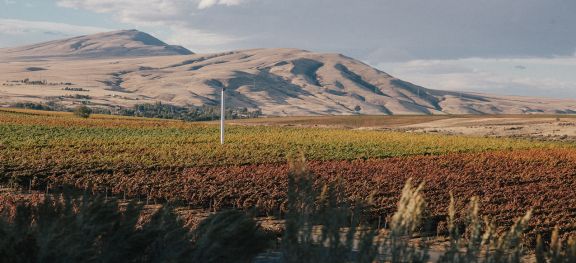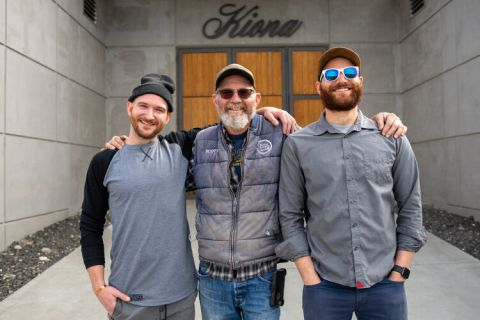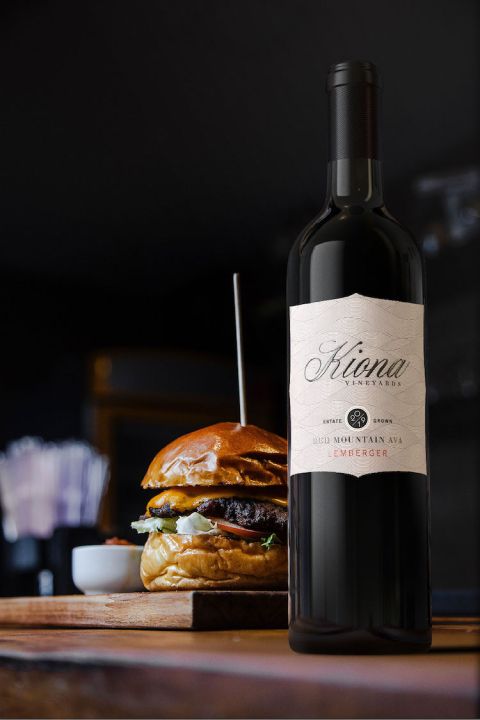Kiona Lemberger 2019 Red Mountain

A delightfully affordable transatlantic Blaufränkisch. See also Sam's introduction to Washington.
From $11.99, £15
In the 1970s when John Williams and Jim Holmes bought land in Red Mountain the area was shrub brush and wild grasses. That section of eastern Washington hadn’t seen development. There were no wells or water systems, no electricity and no houses. And there were certainly no vineyards. But the advantage of undeveloped land in an untested area was affordability. It was the best the duo could afford.
Washington State had already established itself as a white-wine region and the general belief was white grape varieties, especially Riesling, were the pinnacle of what the state would offer. But by 1975, Williams and Holmes had planted Cabernet Sauvignon, as well as the then more common Riesling and Chardonnay. Their new planting became Kiona, the first vineyard on what today is known as the Red Mountain AVA.
The following year, in 1976, they helped friends plant next door in what would become the Ciel du Cheval vineyard, now famous in Washington. At the same time, Holmes and Williams expanded their Kiona plantings establishing Chenin Blanc, Merlot and Lemberger vines.
By 1978, the first Cabernet was made with Kiona fruit, and the future of Washington State wine began to be rewritten. The intensity, colour and depth found in the reds of Red Mountain surpassed all expectations. Today, the AVA is considered one of Washington’s pre-eminent wine regions. It grows primarily Cabernet, many of which are considered the best in the Pacific Northwest, and some of which are also among the state’s most expensive wines.
So, it is not insignificant that Kiona retains not only its original Cabernet but also its Lemberger and Chenin Blanc. They started their own wine label in 1980, the same vintage from which they released the first Lemberger ever commercially made in the United States.
Lemberger, or Blaufränkisch as it is more often known in Austria (in Germany it is sometimes called Limberger), originates from Central Europe where it can be definitively traced back to the 1860s, but researchers suspect it existed under other names possibly even centuries earlier. It found its way to North America in the early 1900s, carried in by two brothers from Hungary who established it in the vineyards of British Columbia. Not until the 1940s did it reach the United States, when the Washington Research Station brought cuttings in from those original Canadian vines to explore its potential in the state’s uniquely cold winter/hot summer continental climate. (In the late 1970s, UC Davis also brought cuttings from Germany to their nursery in California.)
Since Kiona introduced Lemberger to the country, the variety has quietly proliferated around the United States, establishing small footholds in regions as varied as California, the Finger Lakes and even south-eastern New Jersey. Its secret is the hardiness of the vines and its fruit. It seems to handle a range of growing conditions well.
Samantha Cole-Johnson and I spent a morning in early March at Kiona driving vineyards and tasting the wines with third-generation vintner JJ Williams. (The Williams family, pictured above by Kim Fetrow with, left to right, winemaker Tyler, his father Scott – who helped his father to plant the vineyard – and Tyler’s brother JJ, now has full ownership of Kiona, having purchased the other portion from the Holmes family when they decided to retire.)
While there we tasted the Kiona 2019 Lemberger, which I scored 16.5 and thought was extremely good value for drinking over the next three years. It’s a 13.5% alcohol blend of 76% Lemberger, 14% Merlot, 5% Cabernet Sauvignon and 5% Carmenère. The uniqueness of the variety, the wine’s deliciously mouth-watering character and its highly affordable price made it a standout. I’m always on the lookout for affordable wines worth recommending from North America as high price is a common criticism of US wines. My tasting note reads:
The Kiona Lemberger delivers a complex of dark fruits without heaviness, accented by earthy elements and just enough spice to keep it interesting. The tannin is approachable and there is a combination of desert sage with a sprinkle of rock salt (saline palate stimulation without saltiness) that screams the wine’s origin on Red Mountain. It has the mid-palate focus and mouth-watering length that make it food-friendly.
The winery has a tradition, it turns out, they call Burger and Berg, of enjoying Lemberger alongside a burger, which seems just about right. I like the idea of burgers, a profoundly American food, alongside an unusual varietal that was one of the first of its kind in the country.
For those curious about Kiona’s white wines, the Chenin Blanc is worth looking to too. The Kiona 2021 Chenin Blanc offers a savoury nose that also gives a glimpse of fresh desert herbs while the palate shifts into yellow fruits, fresh acidity and plenty of palate stimulation. Also, it is certified vegan.
The Williams family has led the region in multiple ways. They helped write the Yakima Valley AVA, which was federally recognised way back in 1983. When we visited the tasting room, JJ Williams poured us not only Kiona wines but also those made by other producers in Red Mountain, speaking just as warmly of their wines as of his own.
Kiona has also moved all wines (including those of their top tier) to one standardised, lightweight bottle weighing 470 g (1 lb), down from their previous 900-g bottles. Bravo! Any older vintages still in heavier glass they now offer only out of the tasting room, putting only lighter bottles into distribution. This change has reduced the weight per pallet of wine going into distribution by 600 lb (408 kg), which means a dramatic reduction in carbon footprint generated during transportation. JJ says they have not experienced any negative push-back from consumers from the change in bottle weight.
Wines like Kiona Lemberger miss the flash and high dollar of the region’s most famous wines, but their affordability with reliable drinkability make them something to welcome into the everyday. Ultimately, that also means they bring greater access to pre-eminent regions like Red Mountain.
It is not too difficult to find in the US and Ally Wines, an online specialist in American wine, has good stocks of the wine at £15 in the UK. They will sell by the single bottle.
See all our articles about Blaufränkisch.
Travis Gillett is responsible for our main image of Rattlesnake Mountain, Saddle Mountain and the Kiona Estate Vineyard with Lemberger in this block.
Become a member to view this article and thousands more!
- 15,416 featured articles
- 274,319 wine reviews
- Maps from The World Atlas of Wine, 8th edition (RRP £50)
- The Oxford Companion to Wine, 5th edition (RRP £50)
- Members’ forum
- 15,416 featured articles
- 274,319 wine reviews
- Maps from The World Atlas of Wine, 8th edition (RRP £50)
- The Oxford Companion to Wine, 5th edition (RRP £50)
- Members’ forum
- Commercial use of our Tasting Notes


